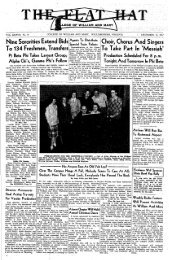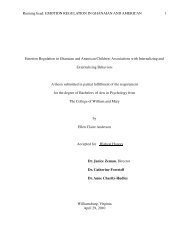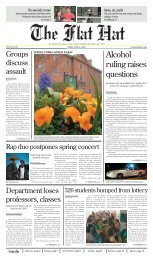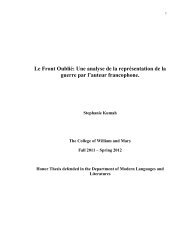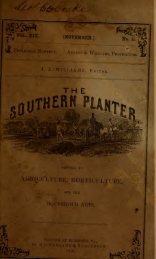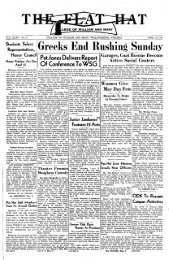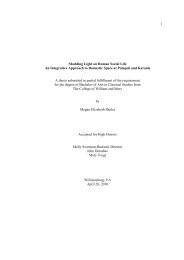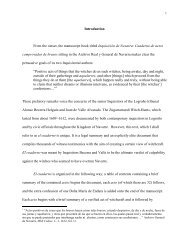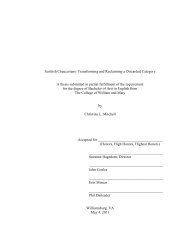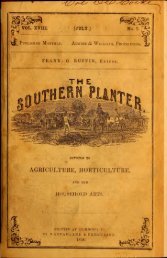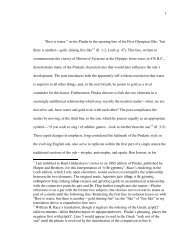Southern planter - The W&M Digital Archive
Southern planter - The W&M Digital Archive
Southern planter - The W&M Digital Archive
Create successful ePaper yourself
Turn your PDF publications into a flip-book with our unique Google optimized e-Paper software.
1908.] THE SOUTHERN PLANTER 31<br />
THE FARMERS' WINTER COURSE AT THE VIRGINIA<br />
POYTECHNIC INSTITUE.<br />
Editor <strong>Southern</strong> Planter:<br />
Two distinct problems in agricultural teaching now con-<br />
front the Land Grant Colleges. <strong>The</strong> first is the technical<br />
preparation of men to advance the sciences on which the<br />
art of agriculture rests, and the other is to devise the<br />
best means of bringing before those who practice the<br />
art of agriculture—the farmers—the facts obtained by<br />
scientific investigation. Three methods have been used<br />
in reaching the farmer: First, agricultural literature, including<br />
agricultural journals of all types and Experiment<br />
Station bulletins, second, the Farmer's Institutes, and<br />
third, the Farmer's winter course. <strong>The</strong> first methods have<br />
the great advantage of wide distribution, and nothing can<br />
take their place. <strong>The</strong> Farmer's Institute is expensive if<br />
carried on on a large scale, but it has the advantage of per-<br />
sonal contact.<br />
Both of the preceding, in spite of their many advantages,<br />
are deficient in one element—they cannot carry with them,<br />
even with best illustrations and drawings, a proper idea<br />
of the apparatus and scientific planjt from which the<br />
truths they enunciate have been drawn. <strong>The</strong> Farmers'<br />
winter course, as given in the Land Grant Colleges, is the<br />
final and last step of a graded system. Here those attend-<br />
ing see it he expensive barn and herds, the proper milking,<br />
weighing, and testing of milk. Spraying and pruning are<br />
shown in the large college orchard, crop pests in museum<br />
cases, forcing methods in the greenhouses, etc. It is of<br />
advantage chiefly to those who have thought and studied.<br />
Coming as it does annually during the farmers' period of<br />
rest in mid-winter, several week's time can be given, and<br />
ward. Shenandoah. Smythe and Wythe. It was a body of<br />
men of unusual intelligence, and many of them of considerable<br />
wealth. About half of them secured accommodation<br />
at the hotels and in private families, but the crowd<br />
who seemed to enjoy it most were those who went together<br />
into the Agricultural Building. Some of the large<br />
lecture rooms of this building were emptied, and iron beds<br />
placed in them in English dormitory fashion. In the<br />
same building were reading rooms with all the agricultural<br />
journals of the country, bulletin rooms, etc. Several times<br />
a week projectoscope lectures, and other methods of entertainment<br />
were given at night. In the basement floor of<br />
the same building, a large room was used for stock judg-<br />
ing, where at one time as many as six Jerseys and six<br />
Guernseys were exhibited side by side for farmer students<br />
to work on with score cards. In the rear of this building<br />
is a battery of five greenhouses, and here the farmers in<br />
small sections, were taught the proper and 5m proper<br />
Miscellaneous.<br />
methods of preparing spraying mixtures—Bordeaux, lime<br />
sulphur, etc. At the barn a twelve horse power engine<br />
was used in demonstrating the practical use of corn<br />
husking and shredding machinery, ensilage outters, etc.<br />
Ail this Demonstration work was done in the afternoon,<br />
while in the morning of the same days lectures were<br />
given on the principles underlying each procedure.<br />
<strong>The</strong> farmers boarded at the college mess at the rate of<br />
$3.00 per week, and they seemed to enjoy very much the<br />
accommodations provided. <strong>The</strong> course of lectures was so<br />
arranged that the general principles of agriculture came<br />
first, then horticulture was added, then animal husbandry,<br />
dairying, etc. A general idea of the course is shown in<br />
the following:<br />
Prof. Davidson: Stable Manure—Commercial Fertilizers—Nitrogen<br />
and Potash—Home-mixed Fertilizers.<br />
Prof. Holden: Origin of Soils, etc.<br />
Dr. Ellett: Soil Physics— Soil Chemistry, etc.<br />
—<br />
—<br />
Prof. Carrier: Silo Construction—Filling Silos—Soiling—Forage<br />
Crops—Crop Rotation—Cropping Systems.<br />
Prof. Price: Locating Orchard—Pruning Vineyard<br />
Growing Orchard—Spraying—Pruning—Orchard Pests<br />
Fruit Harvesting.<br />
Dr. Quick: Breeding of Cattle—Breeding Principles<br />
Feeding Principles—Stock Judging.<br />
Dr. Spencer: Holsteins, Jerseys, Guernseys, Beef Cat-<br />
tle, Swine and Sheep.<br />
Dr. Ferguson: Milk Fermentation—Milk Sterilization<br />
Col. Marr: Farm Surveys—Farm Levels—Land Drain<br />
age—Hydraulic Rams—Roads and Road Making.<br />
Dr. Spencer: Castration—Examining Horses—Wounds,<br />
Col.<br />
experience has proven<br />
Wood:<br />
these courses<br />
Seed Testing—Plant Propagation<br />
to be of the highest<br />
advantage.<br />
Greenhouses.<br />
At<br />
Mr. Holdaway:<br />
the "Virginia Folytechnic Institute such a course was<br />
Babcock Test—Fasteurizing—Cheese<br />
inaugurated this winter<br />
Making.<br />
for the first time. Eighteen coun-<br />
Frof. Hutchison: Plat<br />
ties in the State were represented by one or more<br />
Experiments—Corn Improvement.<br />
farmers,<br />
'<br />
as follows: Albemarle,<br />
Mr. Peyton: Inspection of Barns—Implements—Ma-<br />
Alexandria, Bedford, Botetourt,<br />
Campbell, Culpeper, Floyd, James City, Montgomery,<br />
chinery— Silo Machinery— Silo Filling.<br />
Nelson,<br />
Nottoway, Orange,<br />
Prof Sanders:<br />
Pittsylvania., Powhatan, Prince Ed-<br />
City Milk Trade—Butter Making.<br />
Prof Phillips: Orchard Pests—Grain Insects—Healthy<br />
etc.<br />
Trees.<br />
Dr. Smyth: <strong>The</strong> Relation of Bird Life to Agriculture:<br />
L Hawks and Owls. II. Insects and Grain-Eating Birds.<br />
<strong>The</strong> authorities of the Virginia Folytechnic Institute<br />
nave learned much from the present course. <strong>The</strong>y will be<br />
able to make the next one much better. This course<br />
during the winter of 1908-9 will begin about the first week<br />
in January and last one month. It will be so arranged that<br />
the major part of the first two weeks will be general<br />
agriculture and agronomy, at the beginning of the third<br />
week horticulture, which will last about two weeks, while<br />
the last week or ten days will be devoted largely to dairy-<br />
ing and dairy practice. In this way a farmer can take all,<br />
or if he is a horticulturist or dairyman and wishes to con-<br />
concentrate on these only he can get away in eight or ten<br />
days. Judging from the interest elicited from this course,<br />
it is belived that the number next year will show a hun*



